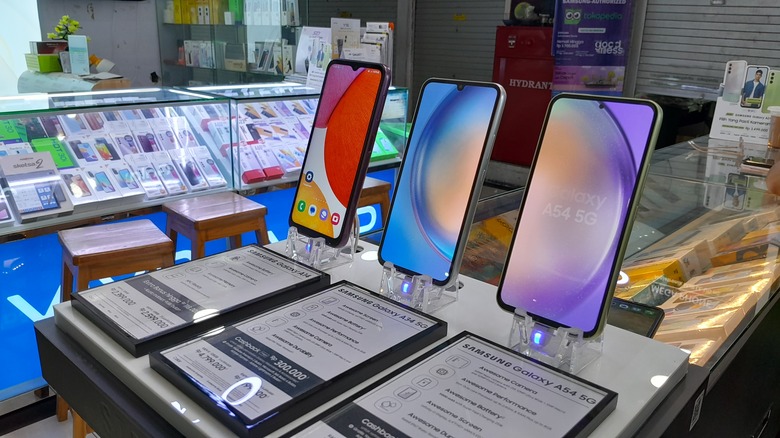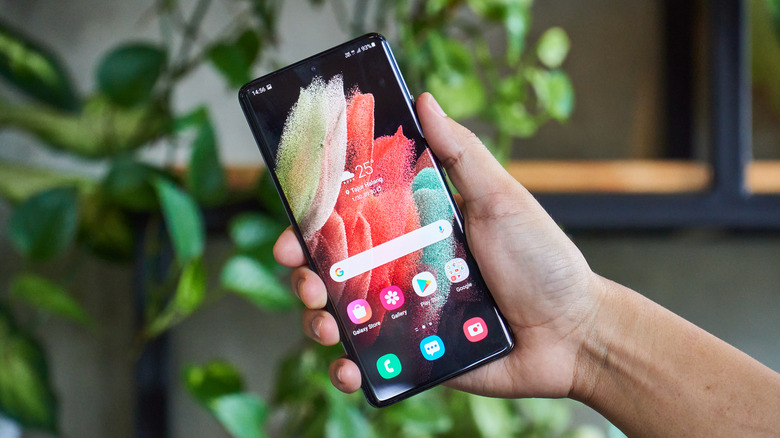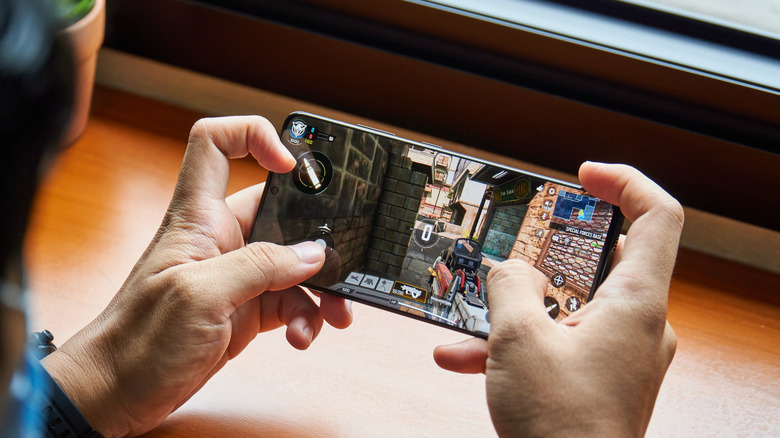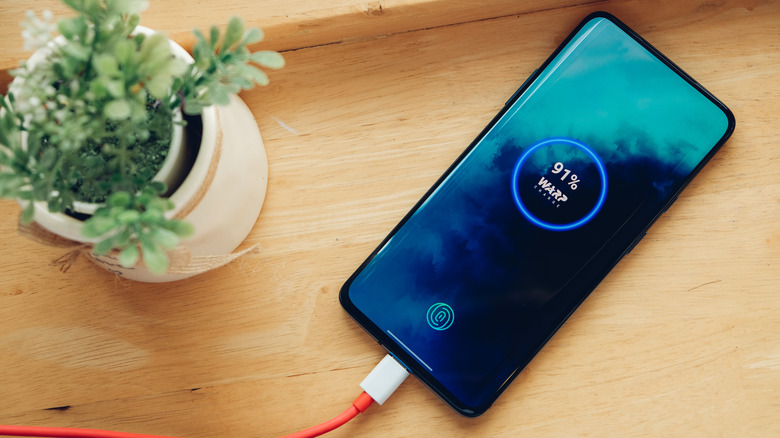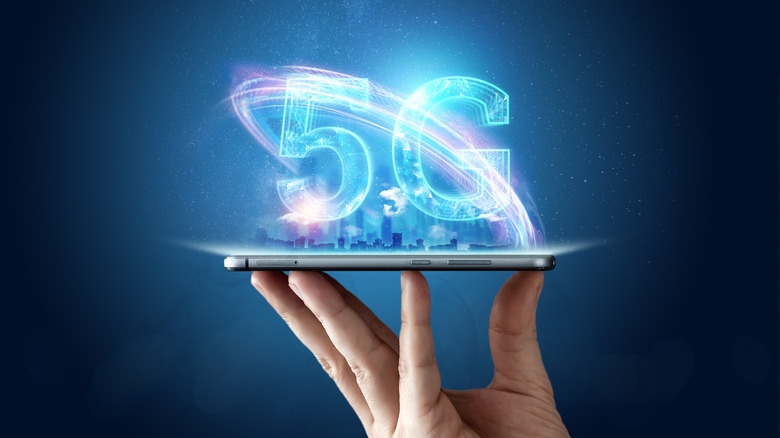4 Important Features You Need To Research Before Buying An Android Smartphone
If you're an iPhone user, choosing your next smartphone is easy. You can't go wrong with the latest iPhone, but if you want a cheaper option, you can buy a previous-generation model. In comparison, buying a new Android phone requires a lot more research.
Several brands make Android smartphones, including Samsung, Google, Motorola, OnePlus, Asus, and Nothing, to name a few. Each of these brands sells a range of models, with most offering a selection of affordable, mid-range, and flagship phones.
Choosing an Android phone comes down to more than just the brand, though. There are several factors to keep in mind, such as how powerful the chipset is, how much RAM it has for multi-tasking, the fast charging speeds, the display resolution, and how many Android updates the brand is promising. You might also want to consider the type of Android skin the phone comes with — for example, Google Pixel and Motorola devices run stock Android, while Samsung and OnePlus come with One UI and OxygenOS, respectively.
Even if you have an Android smartphone in mind, it's worth researching the key features it offers relative to your needs before making a purchase.
Display
Most smartphones have decent displays these days, with even cheap Android devices offering 720p (HD) screens. If display clarity is important, look for something with at least 1080p (full HD) resolution. A higher resolution display will equate to greater PPI (pixels per inch), and given that most Android phones have large screens, 1080p resolution will ensure a better viewing experience.
If you want to stream 4K HDR content on your phone, keep in mind that 4K displays are virtually non-existent on smartphones, barring some Sony Xperia flagships. However, some phones, like the Galaxy S23 Ultra, offer QHD resolution, which is higher than 1080p but less than 4K. Unlike 4K, HDR is far more common on smartphones, with many flagship devices, including the Galaxy S23 and Pixel 8 series, featuring HDR displays.
Another key factor to consider is the refresh rate. Most Android flagships feature high refresh rate screens, as do many mid-range and even affordable devices. A higher refresh rate will ensure that scrolling and swiping are much faster and make the display feel much smoother. A 120Hz refresh rate is ideal, but even 90Hz makes a noticeable difference.
Chipset and RAM
Your smartphone's processor determines its performance, so look for a chipset that meets your needs. If your usage is limited to calling, texting, browsing, streaming, and social media apps, you probably don't need a flagship processor. Popular mid-range phones like the Samsung Galaxy A54 5G (Exynos 1380), Pixel 7a (Tensor G2), and OnePlus Nord N30 5G (Snapdragon 695) should be able to handle most basic tasks.
If your primary requirement is gaming, you'll need a more powerful chipset that can handle the extra load without lagging and freezing. The Snapdragon 8 Gen 2 that powers the Galaxy S23 series is a powerful chip, but Qualcomm updates this lineup every year. Google's Tensor G3 chipset, seen on the Pixel 8 series, is another capable processor.
A processor alone can't determine a phone's performance, though, with the RAM (Random Access Memory) making a big difference, too. The RAM is used to store apps that you've opened, and more RAM means you can have more apps open at the same time, which makes app loading faster and multi-tasking more efficient.
Although you can get cheap Android phones with 4GB RAM, that might lead to sluggishness. While there are ways to optimize your Android phone's RAM usage, if you're on a budget, look for a phone that offers at least 6GB of RAM. 8GB RAM is the sweet spot for most users, but if you're a power user or gamer, consider a phone with 12GB RAM.
Charging speeds
Many Android phones advertise fast charging, but not all charging is equal. Qualcomm's Quick Charge and USB Power Delivery (PD) are the main fast charging standards. Some brands have their own fast charging technology, such as Oppo's SuperVOOC and Xiaomi's HyperCharge. Some phones advertise 15W speeds as fast charging, but those speeds are outdated, particularly since the battery capacity of smartphones has significantly increased.
Modern fast charging should get your phone completely charged in about an hour, with some phones charging completely in under 30 minutes. OnePlus is among the best when it comes to fast charging support, with the OnePlus Nord N30 5G offering 50W charging speeds and the OnePlus 11 going up to 80W. In comparison, Samsung's Galaxy S23 Ultra and Galaxy S23+ support up to 45W fast charging, while the Galaxy S23 only supports 25W.
If your smartphone has good battery life and you tend to charge it overnight, you probably don't need ultra-fast charging. However, if you need to recharge your phone during the day, fast charging can make a big difference. It's also worth noting that fast charging is usually restricted to wired charging. Not all smartphones support wireless charging, but for those that do, speeds are often capped between 15W and 25W, depending on the brand and model.
Network support
Network support is an often overlooked factor when it comes to choosing a smartphone. Your carrier and phone plan will also determine which networks you can connect to. While 4G is still around, it's been largely replaced by 5G. The most common form of 5G is the low-band sub-6Hz 5G. It's only slightly faster than 4G but is widely available. Cheaper 5G Android phones come with sub-6Hz 5G.
If you want the fastest 5G speeds, look for mmWave 5G, which offers speeds in excess of 1Gbps. The downside to mmWave 5G is that it can't penetrate obstacles very well, as a result of which it's restricted to areas like stadiums and densely populated city centers that have cell towers close by. Not all phones support mmWave 5G, and even those that do will only be able to take advantage of the higher speeds in certain areas. Samsung's Galaxy S23, Galaxy Z Flip 5, and Galaxy Z Fold 5 smartphones support mmWave 5G, as do the Pixel 7 and Pixel 8 series.
There's also mid-band 5G (also called C-band 5G), which offers much faster speeds than sub-6Ghz 5G. It also has a better range than mmWave 5G. Most new Android phones are 5G compatible, but if blazing fast speeds are important, look for a device that supports mmWave 5G or C-band 5G. On the other hand, if you value reliability and consistency, you can stick to a phone that supports sub-6Hz 5G.
